2016 Convention Report
Report from Allan Schein
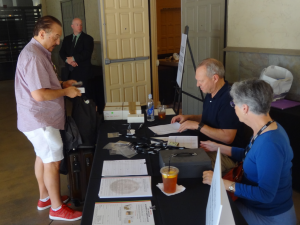
Cory Frampton and Diane Powell sign in Ron Gillio
The 2016 Convention has come and gone, but the memories will last forever. Convention #5 took place at the Hilton Scottsdale Resort in Arizona, as it has in past years, and did not disappoint. This year’s event was larger, better attended and even more fun. The weather was cooler this year for our event, the mead flowed more freely, and there was no Haboob (intense dust storm) as occurred in 2015. Fortunately, this year it came two weeks after the convention when everyone was gone except the locals.
There are many people that have attended this highly social event every year since its inception in 2012. However, one notable individual, our journal’s editor, Simon Prendergast, was once again conspicuous through his absence. Simon, you must attend next year because we are holding the event on the planet Mars. So in the words of Arnold Schwartzeneger in the movie Red Planet, “Get your ass to Mars”. Another notable absentee was our friend Joe Flores, home recovering from knee surgery.
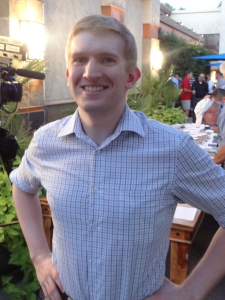
Connor Falk of Daniel Frank Sedwick LLC
Absent for the first two days was World Numismatics’ newest partner, Ben Bell. However the indomitable Ben showed up Saturday morning, along with his dad Rob, wearing sunglasses, a hiking hat and a smile as wide as Arizona itself. His presence elevated all our spirits.
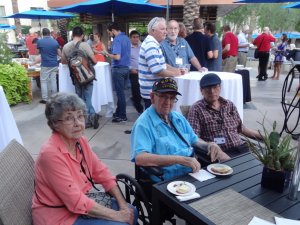
Lois and Don Bailey with Bob Briggs
There were more dealers and even more material available this year than years past. The seminars were well attended, with positive chatter from those who attended after each and every one, without exception. The Bourse floor plan expanded as did the overall number of display cases and exhibits. There were quite a few new faces along with most of the “usual suspects”. New on the scene was Connor Falk, late of Krause Publications and now working with Dan Sedwick, a logical move upwards although with a radical downward geographical shift from Wisconsin to Florida. Exhibiting for the first time was regular attendee Jim Paper of Tempe, Arizona.
A notable attendee was the renowned Don Bailey, in attendance with wife Lois and associate Barbara. They shared a space with Lois’ son Pat Stovall, another regular attendee. The young entrepreneurs of NIA Coins, they being Ali Frampton and cousin Izzy Heath, were both present on set-up day, but Izzy was set to depart to Rome the following morning, and mostly stopped by to say hello to all. This year Ali was again assisted by her friend Gaby. These young ladies are really growing up quickly, and it was enjoyable to see Ali and Gaby lunching on the patio Friday, appearing very much like the young sophisticates they are maturing into.
Our most distant visitor was Mateo Zhao, NGC Director of Business Development in Asia. Mateo, along with NGC Senior World Coins Grader, Jay Turner, purchased numerous coins for their own collections. Not just on the bourse, but at local shops. Mateo and I attended an additional local show on Sunday hosted by the Camelback Coin Club in Tempe.
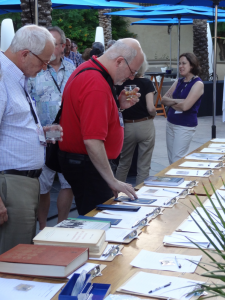
The silent auction this year extended beyond Mexican numismatics to include strawberry mead (donated by Allan Schein). Mars Attacks cards (Kent Ponterio) and various Latin American coins and books on Latin American coinage. However, for the purists, highlights included an 8 reales Philip V cob from the 1715 Plate fleet (donated by Dan Sedwick), an 1812 Sombrerete 8 Reales KM177 (Mike Dunigan), an 1812 Zacatecas 8 Reales KM121 and an Iturbide 1 peso (M10c), with handwritten cancellation on back (both World umismatics), a 1856 Cotija municipal token (Bob Briggs) and a 1915 Campo Morado 50 centavos (GB163) (Cris Bierrenbach).
Books included Resplanadores (donated by Mike Dunigan), El Duro (Don Bailey) and Photographing the Mexican Revolution, by John Mraz (Elmer Powell).
ANACS and NGC both donated lots of free coin submissions.
Many thanks to all these and the others who donated items and to those who bid generously, all helping to improve the Association’s finances.
In all, business appeared to be brisk, the overall mood very upbeat, and social activity considerable, with several instances of excess . Some of those boys from Mexico are definitely resilient in spirit, with great spirit and whileconsuming much spirit.
Mornings at the “resort” start early for many, with breakfast on the outdoor patio in the refreshing morning air. It was here one morning, while dining with Elmer and Diane Powell that I was informed our Brit editor had “Great Expectations” for me, in the form of a report for the journal. There seemed to be no way out of this duty, although I tried to make for the Brexit before committing. Hopefully someone has photos to share because I didn’t take any and never saw Oliver Simons throughout the convention. In the past he has actively documented all aspects of the event, but been diplomatic enough not to publish any compromising images.
Thursday after bourse set-up, we were all treated to a light buffet of snacks sponsored by Cris Bierrenbach while attendees viewed the silent auction offerings and made their bids. Once this segment of the evening was completed, Kent Ponterio and Cory Frampton made presentation to individuals who contributed articles and seminars over the course of the past year.
| In addition to presentations to the 2015 speakers (Mike Dunigan, Dan Sedwick, Kent Ponterio, Angel Smith, Phil Flemming, Allan Schein and Jay Turner) awards were given for the following articles in the journal: | |
| Best overall | Jorge A. Proctor – Assayers of the Mint of Mexico City during the Columnario (Pillar) Coinage 1731-1771) and the Bust coinage (1772-1821) |
| Spanish Colonial | Augustin Garcia-Barneche – “Tumbaga Saga” Treasure of the Conquistadores in Mexico |
| War of Independence & Imperial | Juan Felipe Ramirez Londono – Mexican Independence coins of Eight Real – Indexes of Numismatic Availability – PINA and MINA |
| Republican | Kyle Ponterio – Mexican 8 Reales and their use between America and Japan |
| Revolution | Ricardo Vargas Verduzco – Rediscovery of two Zamora municipal tokens |
| 20th century – Modern | Pablo Luna Herrera – Platinum Coins and Medals in Mexico |
| Paper money – general | Ricardo Vargas Verduzco – Report of Hacienda Los Espinos Paper Money |
| Revolutionary paper money | William Lovett – Revolutionary Paper Money of the West Coast Parts V, VI and VII |
| Jed Crump Award | Kyle Ponterio |
| Richard Doty Award | Oliver Simons |
|
The award ceremony can be viewed at https://youtu.be/fIJs2XVTSog |
|
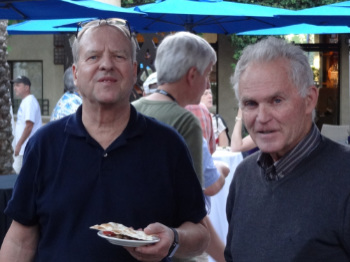 Cory Frampton and Volker Dube
Cory Frampton and Volker Dube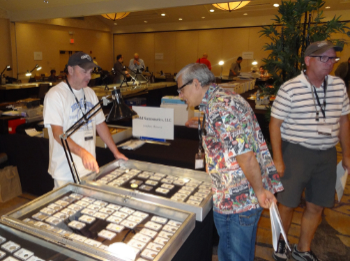 World Numismatics’ table
World Numismatics’ table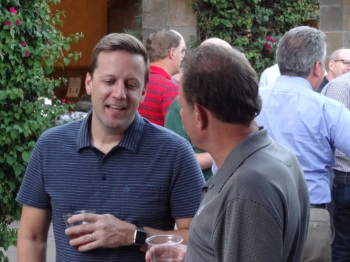 Chris Bierrenbach and Max Keech
Chris Bierrenbach and Max Keech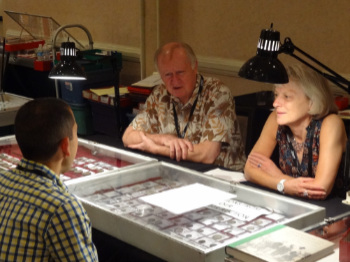 Jim and Peggy Elmen from World-Wide Coins of California
Jim and Peggy Elmen from World-Wide Coins of CaliforniaDavid Lisot of CoinTV captured the festivities as he has for the last few years. He also had available for purchase all the DVDs from previous years seminars for folks who may not have attended, or wanted a replay of the talks.
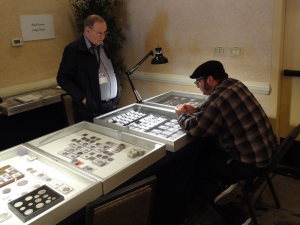
Kent Ponterio Checks Out Paul Kagon’s Stock
Friday evening some of us were able to visit Kent Ponterio’s home for an evening of fun and games; literally. Kent hired a small bus to shuttle friends back and forth, but was forced to limit invitations due to constraints on space and transportation. He generously provided a wonderful array of foods for a catered dinner, and unlimited access to his game room. Now this game room was a thing of beauty. Pinball and arcade video games numbered about 15 units, along with a full size pool table (where Rick Ponterio beat me consistently at 8-ball) and antique shuffleboard table. Good food, great friends, lots of wine, beer and mead, two lovable greyhounds and a relaxed atmosphere made for a wonderful evening. Kent took time to give me a loving explanation on the Evolution of Acceptance before being called away on his duties as a host. Thanks, Kent.
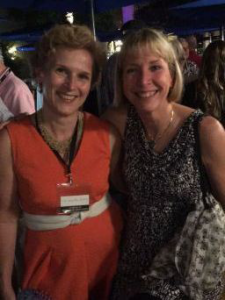 Ute Wartenberg Kagan, longtime executive director of the American Numismatic Society, and Cori Sedwick Downing
Ute Wartenberg Kagan, longtime executive director of the American Numismatic Society, and Cori Sedwick Downing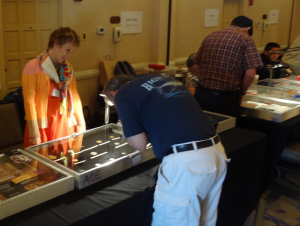 The American Numismatic Society’s display
The American Numismatic Society’s displayI personally attended only one of the seminars, “Identifying Counterfeits”. This was a hands on workshop presented differently than in years past. Each table of about eight people were shown about a half dozen coins and asked to determine if they were genuine or fake. We were to make our assessment and notes on a numbered sheet, then one of three supervisors explained coin by coin if we were correct or not, and why. The supervisory staff was Mike Dunigan, Kent Ponterio and Dan Sedwick. This was very informative and showed clearly how difficult accurate identification is for Portrait Dollars. Angel Herrera Smith did best at our table. I was only 45% accurate. I’m good with Caballitos though.
At day’s end Saturday, it was once again time for gathering on the patio and sharing beverages and the company of friends. This evening it was with ANS Director Ute Wartenberg and Peter Dunham, later to be joined by Cory Frampton. The conversation was light and humorous, a fitting close to the convention’s events.
As in the past, this was a successful and enjoyable event, and gets better every year. My thanks to all who did so much hard work to make it happen and the attendees who came from far and wide that made our organizers’ efforts worthwhile.
Allan Schein
Presentations
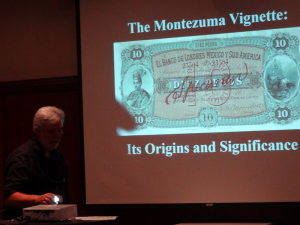 Peter Dunham
Peter DunhamCori Sedwick Downing presented some of her ongoing research on so-called Charles and Joanna coinage from the first mint in the New World at Mexico City. This was a mixture of basic information for those not very familiar with these pre-cobs and advanced information about the many rarities. With photo examples she illustrated what some of the earliest coins from the mint (which probably began production in the spring of 1536) looked like, and also showed with examples Early vs. Late Series coins. Overassayer coins illustrated the progression from one Early Series assayer to the next. A highlight was the discussion of rarities in both Series. Attendees also got to see some error coins, which are few in number compared to other coin time periods. Cori also shared some statistics on the numbers of coins and varieties by assayer. based on her years of research.
Kyle Ponterio discussed Philippines Countermarks Concerning Mexican host coins to a full attentive audience, with many examples shown during his presentation, being numismatic rarities in their own right. The Philippines, one of Spain’s last strongholds in Asia and major commercial center, started revalidating specie imported into the colony which included millions of coins from former Spanish colonies as well as other coins found in commerce. The first form of revalidation was in 1828 by completely overstriking the host coins; this method would ultimately fail and would be switched to hand held dies in 1832 and then again in 1834 with the change of monarch to Isabella II. While conducting his research Kyle has amassed more than 2,200 images, a plethora of host coins and denominations in both gold and silver with more than 500 of those being from various Mexican mints. Pieces of note shown included a 1287(1827) Ga FS 8 Reales, one of only four examples known to exist and specifically cited in Resplandores as such which had been overstruck with the Manila 1828 dies. Other interesting examples included an 1829 EoMo LF and 1828 EoMo LF 8 Reales countermarked with “F.7.0” (Ferdinand VII) 1832-34 and “Y.II.” (Isabella II) 1834-37 respectively. While some of the examples shown may not be the most interesting in terms of Mexican numismatics, common mints and dates ‘Cap & Ray’ 4, 2 and 1 Reales certainly garner much interest being a Philippines countermarked coin.
Peter S. Dunham, PhD, Associate Professor of Anthropology, Cleveland State University, spoke on the ethnic and political history of banknote vignettes. Using the Montezuma vignette on the $10 El Banco de Londres, México y Sud America note, Peter presented images of Montezuma throughout history to identify their origins. Multiple images of Montezuma covering the Hapsburg reign in Europe, European and world history and Mexican history showed how Montezuma was presented to the Mexican people. The crown or headdress, sceptre, royal clothing etc. were analysed and discussed in detail.
On Saturday morning Phil Flemming spoke to a full room about the Mexico City gold coinage of 1711-12. In those two years, for reasons that are still not understood, the Mexican mint simultaneously introduced two new reverse designs for its escudos. Both designs were difficult to execute and had been abandoned by 1714, when the simpler and final design of the cob era (1679-1732) was introduced. Recent archival work hints that political rivalries and enmities may have a played a role in the introduction of the 1711-12 gold coinages. The audience wanted to know more about the wealthy and powerful personalities involved and seemed not at all surprised that politics may have reached into the mint.
Despite being the last presentation of the day Carlos Jara’s talk had a surprising good attendance. Carlos presented evidence linking Costa Rica’s first official issue of 1822 (described in contemporary documentation as “an imperial crown punch on Provisional 8 Reales received from Panama”) and the early Mexican War of Independence issues. Historical evidence points out, as shown by Jara, that San Blas rose in importance from its trade with Panama and other locales south of Mexico when access to the “usual” ports of Veracruz and even Acapulco was blocked by the insurgents. After explaining how provisional coinage from the northern mints must have reached Panama starting in 1812-1813, two examples of the provisional bust type issued in Zacatecas and Chihuahua were identified as pertaining to the aforementioned Costa Rican countermarked issue. Questions from the floor focused on the current population of known examples, so it appears that Carlos’ theory was accepted.
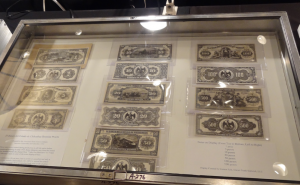
Exhibits
The award for the best display went to Kyle Ponterio for his “Philippines Countermarks Concerning Mexico”. Second prize went to Michael Ontko for his “A Mintmark Set of Gold Half Escudos, 1825-1870” whilst third went to Connor Falk for his “El Banco del Estado de Chihuahua Bromide Proofs”.
Other exhibits included “El Banco de la República Mexicana” from Cory Frampton.
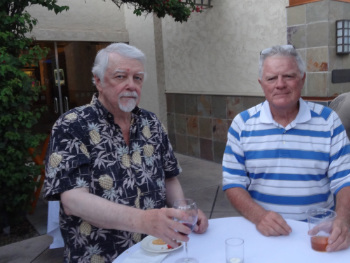 Mark Wm. Clark and Dave Busse
Mark Wm. Clark and Dave Busse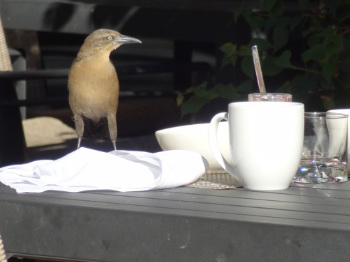 The Clear Up
The Clear Up